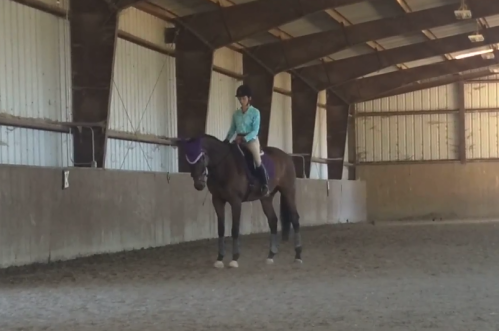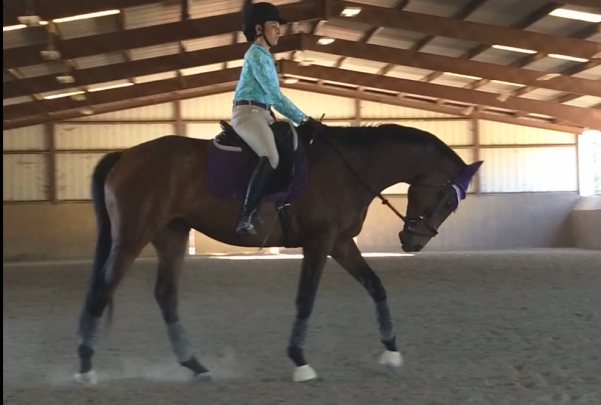My biomechanics clinic lesson on Sunday was not as biomechanics-y as the other lessons at the clinic, but it was still really valuable. One could loosely refer to it as a “be very clear and consistent” lesson, or a “ride better for better horse” lesson, or perhaps a “don’t be an asshole” lesson. But all of the “do this betters” were very specific and followable instructions.
There is something to be said for riding with someone who doesn’t know your horse. Murray and I rode with her last time, and for both lessons he was pretty angelic. Sure, we weren’t doing the hardest work, but it wasn’t nothing either. Alexis did a really excellent job of coaching the horse and rider that showed up to the clinic — not what we might be, not what we thought we were, not what she thought we were. She just took what we had and worked with that, which is exactly what she told me to do with Murray.
 accurate representation of how we’ve spent a lot of time lately
accurate representation of how we’ve spent a lot of time lately
We started with the “what have you worked on since last time” chat. I have been working pretty hard at twisting right and making my posting clear, but have not been working hard on my bear down. I also recently started trying to sit a little closer to the front of the saddle instead of back toward the cantle, and habituating Murray to more correct aids. For example, I’m trying not to give up on the walk before moving on to the trot, and really trying to enforce that leg = forward.
Alexis asked me what I do to not give up on the walk before moving to the trot. I told her that I take up some contact at the walk and try to keep pushing Murray toward it. I try to see where he is each day and meet him there, and then slowly push him for a little more than he is wiling to start with. If he’s feeling fractious, I back off a bit. If the lesson took us there, I also wanted to work on my down transitions. They tend to happen in a heap and on the forehand and I hate them.
First, Alexis gave me a little lecture about approaching training the right way — i.e., not rewarding bad behavior/tension/incorrect responses by giving up the aids. (I do actually know that, but all of my skills, abilities, and knowledge in animal training and behavior seem to go out with window when it comes to riding.)
Then we talked about how she wanted me to approach Murray’s lack of response to leg aids. Alexis said that Murray seems to be a relatively sensitive guy, and sensitive horses in particular often become dull to repetitive/noxious/meaningless aids as a method of self preservation. (This is always something that has confused me because he is sensitive, but at the same time just ignores the fuck out of my leg.)
“If someone was kicking me in the guts all the time, I’d probably tense up and ignore them too,” was her exact analogy.
Err right. That is all true, and logical.
 this is NOT the walk mechanic you are looking for, and also WTF are you doing why are you putting your nose on your chest?!!?!
this is NOT the walk mechanic you are looking for, and also WTF are you doing why are you putting your nose on your chest?!!?!
Alexis wanted me to silence all of my aids and start reprogramming myself and Murray using the smallest possible aid, starting with halt-walk-halt transitions. So off she sent me on the circle to walk without harassing or nagging and keeping an exceptionally still leg. I still needed to keep my other positional fixes (twist right, bear down, short reins), and maintain a following hand. But no other aids were there to be.
I whined a bit about it at first.
I can feel the walk moving my torso side to side, I said. That’s because you’re sloshing your torso around, Alexis responded.
Why are you shoving him along with your seat? Alexis asked. Because he’s walking SO SLOWLY, I whined. He’s not walking that slowly, she told me. Stop nagging.
And then I was to halt. I asked Alexis to clarify the halt aids for me so I could make sure they were right she wouldn’t see me just hauling on my horse’s face to get him to stop. Alexis told me to tighten my thighs to still the following nature of my seat, and fix my hand so that the motion of the walk was not “allowed”.
After the halt, I could squeeze Murray gently, ONCE, to ask him to walk. If he didn’t respond within “one potato”, then I could squeeze again ONCE and follow it immediately with a tap from the whip.
His first response was a bit sluggish but didn’t earn a tap. The next go around I bumped Murray with my leg, and before “one potato” was up, I bumped again. Alexis was like “nope, you don’t get to do that. One little kick.” She also encouraged me to think about giving the aid more with the top of my boot than with my heel, to minimize the size of the aid.
 tippity-tappity warm up trot
tippity-tappity warm up trot
After six or seven walk-halt-walk transitions, we moved on to trot. Alexis wanted me to ask Murray to trot in the same way — a little squeeze — and then keep posting without kicking him for exactly as long as Murray wanted to trot for. When he walked, I would just go ahead and stop posting.
So we did an ugly walk-trot transition (more on that later), and trotted. And trotted. And trotted. And trotted. Alexis was like “Okay this is great information. He’s really quite willing to trot around, so he’s not all that lazy after all.” OKAY FINE ALEXIS FINE, MY HORSE ISN’T A LAZY ASSHOLE I GUESS I AM.
The next task was to finesse the walk-trot transition. There were problems with the transition outside of the aid. Murray is a push-back type. He doesn’t want to seek the contact, so he inverts. I was exacerbating this, as I ceased to follow the motion of the walk with my body and hands as I asked for the aid, and just stilled my my hand and kicked at the same time. I also lost my bear down and anticipated/pitched forward a tiny bit. Instructions: keep the bear down, keep the hands following, still do the transition.
In the next set of trot walk, I told Alexis that I felt like Murray was progressively losing energy. She said I could give him a little aid to encourage him to trot a bit bigger, but no nagging. Alexis also encouraged me to make the aids short and inviting — the aid should make Murray want to trot, not make him think “oh fuck, I’d better trot now”. She wanted the release of the aid to encourage the behavior, not the progressive clamping down of my legs.

I look like some kind of deranged clown but ignore that!! look how nice Murray’s neck is!
As I trotted around, Alexis kept reminding me to keep my legs very still and not bump him. She almost wanted me to feel like I was kneeling and sticking my heels out a little bit, with my lower leg away from Murray’s body. I think this also included stabilizing more through my thigh.
Once again, this biomechanics post has become far too long. So I’ll split it into two, with the canter mechanic and down transitions, and a couple of other big take-aways in another post.
But the big, horrifying piece of news is that, once again, I’m having to totally reprogram the way I ride and train my horse because it’s not him, it’s me.
One day, one day, I will be able to ride my willing and forward horse accurately and precisely and without intentionally or unintentionally fucking him up. One day. (Hopefully a soon one.)
I am guilty of a sloshing torso too! But yep reprogramming here too. I look at it this way, constant pursuit of betterment!
LikeLike
Oh man, this is all so fascinating! I need this kind of lesson!
LikeLike
Thanks for the informative post, I love how in depth you go into all of this. I have a different horse and different problems as a rider so lessons aren’t always transferable (though it’s amazing how often they are), but I think these are all still things we can check in with ourselves.
LikeLike
Carlos was the same, when I realized that nagging him just made him do his own thing rather than my thing I went about revaluating our gas and brakes relationship. Sounds like a fab lesson!
LikeLike